3rd International Conference on Energy and Sustainability
11 - 13 April 2011
Alicante, Spain
Overview
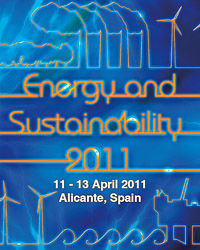 The third International Conference on Energy and Sustainability took place in Alicante, Spain, organised by the Wessex Institute of Technology (WIT) and the University of Alicante with the collaboration of the University of New Mexico, USA. The University of Alicante was represented by Professor Yolanda Villacampa, Co-chair of the meeting together with Professor Carlos Brebbia from WIT and Professor Andrea Mammoli from New Mexico. The meeting was supported by the Ministerio de Ciencia e Innovación (ENE2010-10879-E) of Spain and the Caja Mediterranea, a well-known regional bank.
The third International Conference on Energy and Sustainability took place in Alicante, Spain, organised by the Wessex Institute of Technology (WIT) and the University of Alicante with the collaboration of the University of New Mexico, USA. The University of Alicante was represented by Professor Yolanda Villacampa, Co-chair of the meeting together with Professor Carlos Brebbia from WIT and Professor Andrea Mammoli from New Mexico. The meeting was supported by the Ministerio de Ciencia e Innovación (ENE2010-10879-E) of Spain and the Caja Mediterranea, a well-known regional bank.
Today, energy is derived primarily by the combustion of solid fuels. The consequences of reliance on these are well known – climate change and resource depletion. There is also high likelihood that the feedback into the world economy in the medium to long-term will have negative results.
In recent years there has been a number of encouraging technological developments. For example, the oil industry is a mature technology, which can compete with coal in terms of unit energy cost, even if the externalities associated with coal combustion are not accounted for. Solar photovoltaics have recently become less expensive and this downward trend may continue. Hybrid and fully electric cars are becoming available. These and others are indicators that renewables can significantly contribute to the energy balance in the future.
In many cases the challenge lies as much in the conversion from primary renewable energy (wind, solar, etc.) to useful forms (electricity, heat, fuel) at an acceptable cost, as in the integration of these resources into existing infrastructures. Research, industry and government institutions are now addressing the need to match the energy source to the end use.
The appropriateness of a particular energy pathway to the end use was discussed in some of the papers in the conference. The question of resource identification and characterization, including cost, is addressed in many papers. The topic of reliability and robustness of renewable energy resources and applications, old and new, was also discussed.
Opening Address
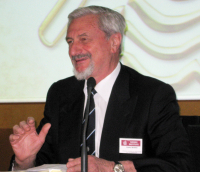 Professor Carlos Brebbia opened the meeting explaining the importance of the conference in terms of the work done at WIT. The Institute, Carlos said, acts as a hub for the exchange of knowledge. This is carried out by holding conferences, such as Energy and Sustainability, courses and postgraduate research, publications such as books and journals (in digital format as well as paper format).
Professor Carlos Brebbia opened the meeting explaining the importance of the conference in terms of the work done at WIT. The Institute, Carlos said, acts as a hub for the exchange of knowledge. This is carried out by holding conferences, such as Energy and Sustainability, courses and postgraduate research, publications such as books and journals (in digital format as well as paper format).
Professor Brebbia described some of the most recent projects carried out at WIT, and their practical importance. The Industrial Division of WIT in particular has been instrumental in developing novel computational methods and releasing them in the form of tools that can be easily applied in practice.
The Institute continues to grow and develop better facilities which provide a better and more productive research environment.
Professor Brebbia ended his welcoming remarks by stating that WIT is always keen to strengthen links with other institutions around the world.
Keynote Address by Professor Jerry Conners
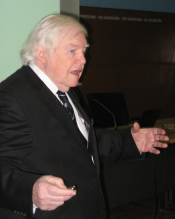 Professor Jerry Connor of the Department of Civil Engineering at the Massachusetts Institute of Technology (MIT) opened the technical sessions with a talk on Energy Initiatives at MIT. The work concentrates on more efficient use of energy, developing new supplies of energy, mitigating the environmental impacts and minimising the potential harmful effects to achieve the transition from current energy sources to a sustainable future.
Professor Jerry Connor of the Department of Civil Engineering at the Massachusetts Institute of Technology (MIT) opened the technical sessions with a talk on Energy Initiatives at MIT. The work concentrates on more efficient use of energy, developing new supplies of energy, mitigating the environmental impacts and minimising the potential harmful effects to achieve the transition from current energy sources to a sustainable future.
The big challenge is that 80% of primary energy sources are fossil fuels. There is no obvious successor to solid fuels, while their sources are dying out. There is a great uncertainty regarding how to replace them due to the problems of the nuclear industry.
The USA’s energy production requires 36% of oil, 23% of natural gas and 20% of coal. Only 7.7% comes from renewable resources. There has been no reduction of USA’s oil deficit at present, the gap between production and consumption continues to be the same. To all this we have the added problem that the existing energy infrastructure represents an enormous capital investment
The scope for innovation is in the areas of;
- Hydrocarbon Products and Processing
- Nuclear Power
- Electric Power Systems
- Heat Management
- Industrial Energy Efficiency
- Carbon Sequestration
- Building Efficiency Technologies
85% of US energy consumption is fossil fuels, 67% of electricity and 100% of transportation runs on hydrocarbons. We need to find clean technologies – particularly for coal, focus on carbon capture, develop highly efficient technologies and search for natural gas resources (shale gases). The predictions are for major development of shale gas which in 2035 is expected to represent 45% of hydrocarbon energy sources with the rest of the world poised in that direction.
A major energy consumer is the building industry. We need to make buildings smart, produce new technologies for lighting and heating, better isolation, amongst others.
MIT is setting up a project to compare all the alternatives to save energy, reduce carbon footprints and develop new guidelines for energy use. The aim is to reduce the electricity use by 5% per year through retrofitting of lighting, changing some construction features, improving heating and air conditioning. It has been calculated that the investment payback is of 2 to 3 years.
Another important initiative is the development of cleaner coal technologies with CO2 sequestration. China, which relies on coal is building two power plants per week. This gives added urgency to the need to develop strategies of how to deal with CO2 generation.
New solar cells are required to optimize this type of energy. The challenge now is to create organic solar cells. Other new ideas are in solar thermal fuels, and the development of new materials that can store energy.
In conclusion, Professor Connors thinks that ‘shale’ gas could be a major development. In the field of renewables, wind energy is not welcome onshore but is feasible offshore, which requires bringing the energy from there. Solar energy has been considered but one needs to improve the efficiency. Alternative fuels such as biofuels do not make sense. MIT has set up a multidisciplinary team to look at the energy problem in general.
Address by Dr Rolf Sjöblom
Following Professor Connor’s keynote address, Dr Rolf Sjöblom from Tekedo AB spoke about the sustainability of nuclear energy with regard to decommissioning and waste management. He discussed the problem of sustainability aspects of nuclear power versus environmental liabilities associated with the decommissioning of nuclear facilities and with waste management.
It is important to assess the availability of uranium and the efficiency of its utilization, the protection of health and environment. It is essential that our generation leaves behind solutions for the problems we create. Planning for decommissioning is vital to the nuclear power process.
Conference Topics
The remaining conference papers were grouped into the following topics;
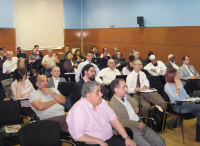 Renewable energy technologies
Renewable energy technologies- Biomass processes and biofuels
- Energy management
- Energy policies
- Energy and the environment
- Energy analysis
- Energy efficiency
- CO2 sequestration and storage
Invited Presentations
There were a series of invited presentations to enhance the proceedings;
‘Design guidelines for a robust and reliable solar thermal heating and cooling system’
A. Mammoli, University of New Mexico, USA
‘High yields of sugars via the non-enzymatic hydrolysis of cellulose’
J.-M. Lavoie, University of Sherbrooke, Canada
‘Environmental balance study for the construction of a biomass plant in a small town in Piedmont’
G. Genon, Politecnico di Torino, Italy
‘Biodiesel reforming with a catalyst for the production of renewable SOFC fuel’
N. Abatzoglou, University of Sherbrooke, Canada
International Scientific Advisory Committee
The International Scientific Committee met to discuss the conference and decided the changes that may be required for Energy 2013. The general consensus was that most of the topics in the Call for Papers have been covered by the presentations. It is nevertheless important to define new areas of research and in particular the way in which the conference can be shaped in 2013. A topic of current interest relates to the risk involved in energy plants and the environmental damage that different types of energy production can cause. Another application of importance are those connected with energy storage and transmission. These and other topics will be incorporated in the 2013 Call for Papers. Several nominations were received for new members of the committee and possible locations were discussed. The members met afterwards for dinner in a well-known local restaurant.
The Prigogine Award 2011
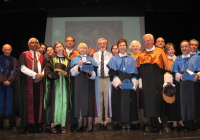 The conference closed with the Prigogine Award ceremony. The Prigogine Gold Medal was established by the University of Siena and the Wessex Institute of Technology to honour the memory of Professor Ilya Prigogine, Nobel Prize winner for Chemistry and renowned for his work on biological and complex systems. The ceremony, which took place at the Events Center of the Caja Mediterranea, was presided over by the Vice Rector of the University of Alicante, Professor Manuel Palomar who showed the commitment of the academic institution to excellence in research as well as higher education.
The conference closed with the Prigogine Award ceremony. The Prigogine Gold Medal was established by the University of Siena and the Wessex Institute of Technology to honour the memory of Professor Ilya Prigogine, Nobel Prize winner for Chemistry and renowned for his work on biological and complex systems. The ceremony, which took place at the Events Center of the Caja Mediterranea, was presided over by the Vice Rector of the University of Alicante, Professor Manuel Palomar who showed the commitment of the academic institution to excellence in research as well as higher education.
Ilya Prigogine was born in Moscow and obtained his undergraduate and graduate education at the Free University of Brussels. He was awarded the Nobel Prize for his contribution to non-equilibrium thermodynamics, particularly the theory of dissipative structures. The main theme of his scientific research was the role of time in physical science and biology. He contributed significantly to the understanding of irreversible processes, particularly in systems far from equilibrium. The results of his work have had profound consequences for understanding not only biological and ecological systems but also a range of problems in social and political sciences.
The Medal has been awarded to outstanding scientists who have been influenced by the work of Prigogine. Previous Prigogine Award winners have been;
2004 Sven Jorgensen from the University of Pharmaceutical Sciences, Denmark
2005 Enzo Tiezzi, University of Siena, Italy
2006 Bernard Patten, University of Georgia, USA
2007 Robert Ulanowicz, University of Maryland, USA
2008 Ionnis Antoniou, University of Thessaloniki, Greece
2009 Emilio del Guidice, Institute of Nuclear Physics, Milan, Italy
2010 Felix Müller, University of Kiel, Germany
Professor Patrick De Wilde of the Free University of Brussels described the personality and career of Ilya Pigogine who was an academic member of staff at the same Institution. Prigogine, Patrick recalled, created a large research group working in complex problems, entirely supported by the Solvay Institute where his work started to attract international attention. Patrick remembers his clarity as a lecturer and the excellent course books.
The event was dedicated to the memory of Professor Tiezzi who was instrumental in setting up the award. Professor Ricardo Pulselli from the University of Siena, described the work of Enzo and he importance of his legacy which has influenced many young researchers all over the world.
Ricardo referred to the extraordinarily productive output of Enzo who not only was concerned with scientific problems but also wrote books and poems. His range of interests was wide and embraced all areas of human behaviour, following the example of his mentor, Ilya Prigogine.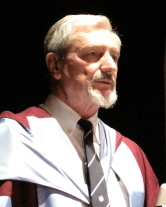
Professor Carlos Brebbia, Director of Wessex Institute of Technology, then introduced the awardee. The 2011 medal was awarded to Professor Larissa Brizhik of Bogolyubov Institute for Theoretical Physics in the Ukraine, who is also a member of the International Institute of Biophysics in Neuss, Germany.
Larissa studied physics at Kiev State University before completing her PhD at the Bogolyubov Institute. Her current research interests included electro-photon interaction, soliton mechanism for energy storage and the influence of electromagnetic radiation on biological systems amongst others.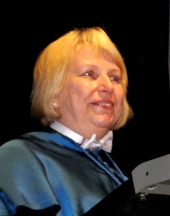
Her current research interests included electro-photon interaction, soliton mechanism for energy storage and the influence of electromagnetic radiation on biological systems amongst others.
Larissa has published a substantial number of papers in leading scientific journals and has participated in many conferences around the world.
Larissa then delivered her Prigogine lecture entitled 'On the role and impact of electromagnetic fields in Ecosystems’. The full text of her lecture can be found in the International Journal of Design and Nature & Ecodynamics.
Conference Dinner
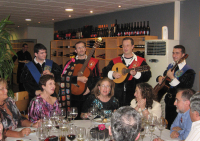 The conference banquet took place in the Royal Regatta Club of Alicante where the participants were taken by boat from the hotel. There they tasted a series of regional dishes and excellent local wines. At the end of the dinner a student group (called Tuna in Spanish) from the University performed different pieces for the participants. The event was an excellent way to end a very successful conference.
The conference banquet took place in the Royal Regatta Club of Alicante where the participants were taken by boat from the hotel. There they tasted a series of regional dishes and excellent local wines. At the end of the dinner a student group (called Tuna in Spanish) from the University performed different pieces for the participants. The event was an excellent way to end a very successful conference.
The conference will be reconvened in 2013 at a date and location to be shortly decided.
Publication of Proceedings
The proceedings of Energy and Sustainability III, 528pp (Print ISBN: 978-1-84564-508-3; Online ISSN: 1743-3541) are available from WIT Press priced at £227/US$454/€318. Orders can be placed on the WIT Press web site at www.witpress.com or by email: This email address is being protected from spambots. You need JavaScript enabled to view it., telephone: +44 (0) 238 029 3223 or fax: +44 (0) 238 029 2853.
Papers from the conference will also be hosted online at the WIT eLibrary as Volume 143 of WIT Transactions on Ecology and the Environment (On-line ISSN: 1743-3541). For more details visit the WIT eLibrary at http://library.witpress.com



 Wessex Institute
Wessex Institute